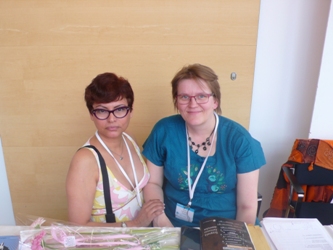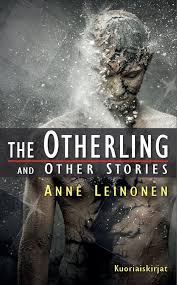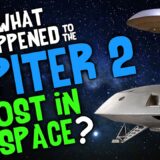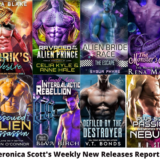Because Worldcon 75 will be in Finland (YEA! BIG SMILES! ETC!!!!!) I will be conducting some interviews and more with Finnish writers and fandom. Here is the first one:
 Tanya Tynjälä for Amazing Stories: Why have chosen science fiction? What does it offer you that another genre doesn’t?
Tanya Tynjälä for Amazing Stories: Why have chosen science fiction? What does it offer you that another genre doesn’t?
Anne Leinonen: Science fiction allows me to ask ”what if” questions, even multiple times within the same story. As a child in the countryside I used to stare at the sky and wonder what´s there beyond the stars. Now I can ask similar questions, but on a wider scale: study the everyday life and choices we make, but see them from a different angle than in mainstream prose… I like to take something most of us think as normal and twist it a little bit and see what´s inside.
Science fiction kindles a sense of wonder within me: the scale of something might be so enormous it makes me feel small, or maybe a small thing might hold enormous things inside of it. Societies of ants and bees are very complex even though we tend to think that they are tiny little creatures.
AS: What are the themes that interest you and why? How do you use them in your work?
AL: I have always been interested in otherness and people in conflict with society. Sometimes the “otherness” is a common thing like gender, sometimes something much more complex like being an alien or a survivor in some post-apocalyptic world. I am interested in memories and false memories, the way we are telling our own history and memorizing things the way we like to (not necessarily the way they really happened). I like to put my characters into a maelstrom and see how they survive.
AS: Do you consider your work to be influenced by Finnish mythology? If yes, is it your choice or something you cannot avoid?
AL: It is always possible to decide that you´ll avoid certain influences, but it´s a different thing to actually manage to avoid something that surrounds you everywhere.
Finnish mythology and especially nature is woven into our language – in idioms, within the way we use our language. And as a writer I am very eager to use my heritage – that is something I know quite well.
Our mythology, the national epic story Kalevala is often the only thing a foreigner knows about our culture, but there´s much more than that. One of my favorite sources is “Myytillisiä tarinoita” (Mythical stories), a collection of folklore gathered from Finnish peasants. Originally Finns don´t have zombies or vampires in these stories, but very original ghosts, elves and spells.
Naisen väki (The might of a woman) is one of my favourite spell and folkore themes.
The word “väki” may mean many different things but you got the meaning from these translations: väkivoima = force, väkivalta =  violence, väki = people. Elderly Finnish women had very strong spell power, which they used as luck charms. These kinds of long forgotten ways of living interest me. For example my short story “Tuonenkalma, surmansuitset” is about a young girl, whose little brother is not a normal human: he has characteristics of a wolf and is thus driven off to his death into a swamp. The girl saves her brother and thus starts a very strange relationship.
violence, väki = people. Elderly Finnish women had very strong spell power, which they used as luck charms. These kinds of long forgotten ways of living interest me. For example my short story “Tuonenkalma, surmansuitset” is about a young girl, whose little brother is not a normal human: he has characteristics of a wolf and is thus driven off to his death into a swamp. The girl saves her brother and thus starts a very strange relationship.
AS: How does Finnish science fiction differ from English language science fiction? What are its characteristics?
AL: We don´t have a special market for our own sf/f-stories. Realistic literature, especially books concerning the Finnish civil war and World War II, have always been very strong in national competitions and “books that sell” listings. Sf/f has been fighting for space and respect, but the battle has had some advantages: Finnish sf/f authors have been forced to develop themes and issues that are considered “high literature” and have woven them into speculative ideas, or vice versa. And that´s why we have just now so many talented writers, which are blending and mixing different genres and materials into their own styles.
Johanna Sinisalo, Pasi Ilmari Jääskeläinen, Tiina Raevaara, Marko Hautala, Emmi Itäranta, J Pekka Mäkelä, Hannu Rajaniemi and many many others…
Short stories have always been very important to Finns. In fandom we have many zines and semiprozines, which publish short stories (They are not paying markets). Annual writing contests are also important. So we have a very good writing school for new writers who want to do their part in Finnish literature.
AS: Do you think there are socio-cultural influences on developing a native literature and specifically a science fiction literature?
AL: In the last decade Finnish sf/f authors have broken through into the mainstream and are writing very clairvoyantly about our political and social situation. For years Finland has been quite the equal place to live (we have almost free health care, free education and a decent social care network) But now our nation is slowly becoming unequal.
And we are fighting against it. As examples, there have come out many dystopian books which are situated in Finland (Johanna Sinisalo: Auringon ydin (what if Finnish women are tamed and treated like second class citizens), Maarit Verronen: Karsintavaihe (what if people are divided into A,B,C and D-type citizens who are granted rights, work and living space according to their class), Jani Salminen: Äidinmaa (what if Finland is ruled by a matriarchy).
AS: Do you write different for young adult audiences than for adults? Do you prefer writing alone or in collaboration (tandem)?
AL: Tandem writing is easier than writing alone, or so it seems after ten or so books written with a partner. I often get stuck when writing solo and switch manuscripts as I wait for a solution. In tandem work there is always the other person fixing and inventing things. It is also very good to share critiques together. Many of my solo works have quite a long lifespan before publishing – for example I wrote my alternative history/future -story “Ilottomien ihmisten kylä” (The Village) ten years before publication. I have written stories for the YA-market, but I often start planning and writing without dividing my readers into “young” or “old”.
I always try to reach a level of at least three big simultaneous ideas (or novums) so that there are different layers for different readers. When I planned the novel “Viivamaalari” (The Line Painter) I started to mix together different genres from mystery story to science fiction. It was fun to have golems, space ships, aliens and the end of the world all in the same story.
I started my career with short stories and feel that I still want to research the possibilities and styles with them. Short stories have been my “writer´s university”.
AS: You area a mother and a Publisher and an author. How do you manage your everyday life in order to achieve all your goals?
AL: I am used to doing things simultaneously. Writing is mostly thinking and planning, and it´s possible to plan when doing other things. When I have time to write I´ll prefer to put it all down very quickly and edit later. When I have a good amount of text I can print the manuscript and edit it while traveling in a train or a bus.
I have also decided that there are certain things, which I can do with the minimum amount of work. That includes cleaning the house or putting all things in order at home…
AS: What do you think of Worldcon coming to Helsinki?
AL: It is absolutely fabulous! I wasat Worldcon 2006 in Glasgow and enjoyed a lot all the programming and parties. I got so much inspiration from there… I know Worldcon will be a great opportunity for Finnish speculative writers and to all fandom to connect and share. We Finns also have so much to give to the people from other countries. I know we will make an especially memorable con for all!
 About the author: Anne Leinonen (b. 1973) is a journalist, editor and author, and active in the Finnish SF/Fantasy community and has served as the editor-in-chief of the online magazine “Usva” (The Mist) which publishes Finnish speculative fiction.
About the author: Anne Leinonen (b. 1973) is a journalist, editor and author, and active in the Finnish SF/Fantasy community and has served as the editor-in-chief of the online magazine “Usva” (The Mist) which publishes Finnish speculative fiction.
Anne Leinonen has co-authored several YA titles with Eija Lappalainen and their trilogy “Children of the Frost” (Routasisarukset) quickly became their main body of work after the first part was nominated for the most prestigious Finnish children’s and YA literature prize, the Finlandia Junior. “Children of the Frost” is a dystopian adventure trilogy in a vein similar to the works of Ursula K. Le Guin. The biggest Finnish daily newspaper review of “The Children of the Frost” states the book is “a fine example of the Finnish ability to offer a unique response to international trends while remaining cognizant of the genre’s conventions.”
Leinonen’s short fiction has also won multiple awards and her works are noted for the reoccurring theme of “crossing the borders of different worlds”.
Short stories in English
”The Otherling” (Toisinkainen). Usva International 2007. Translation Liisa Rantalaiho
”White threads” (Valkeita lankoja) It Came From the North: An Anthology of Finnish Speculative Fiction. Edited by Desirina Boskovich (Cheeky Frawg Books 2013) Translation Liisa Rantalaiho
Books
“The Otherling and other stories” Published 2015 by Kuoriaiskirjat











